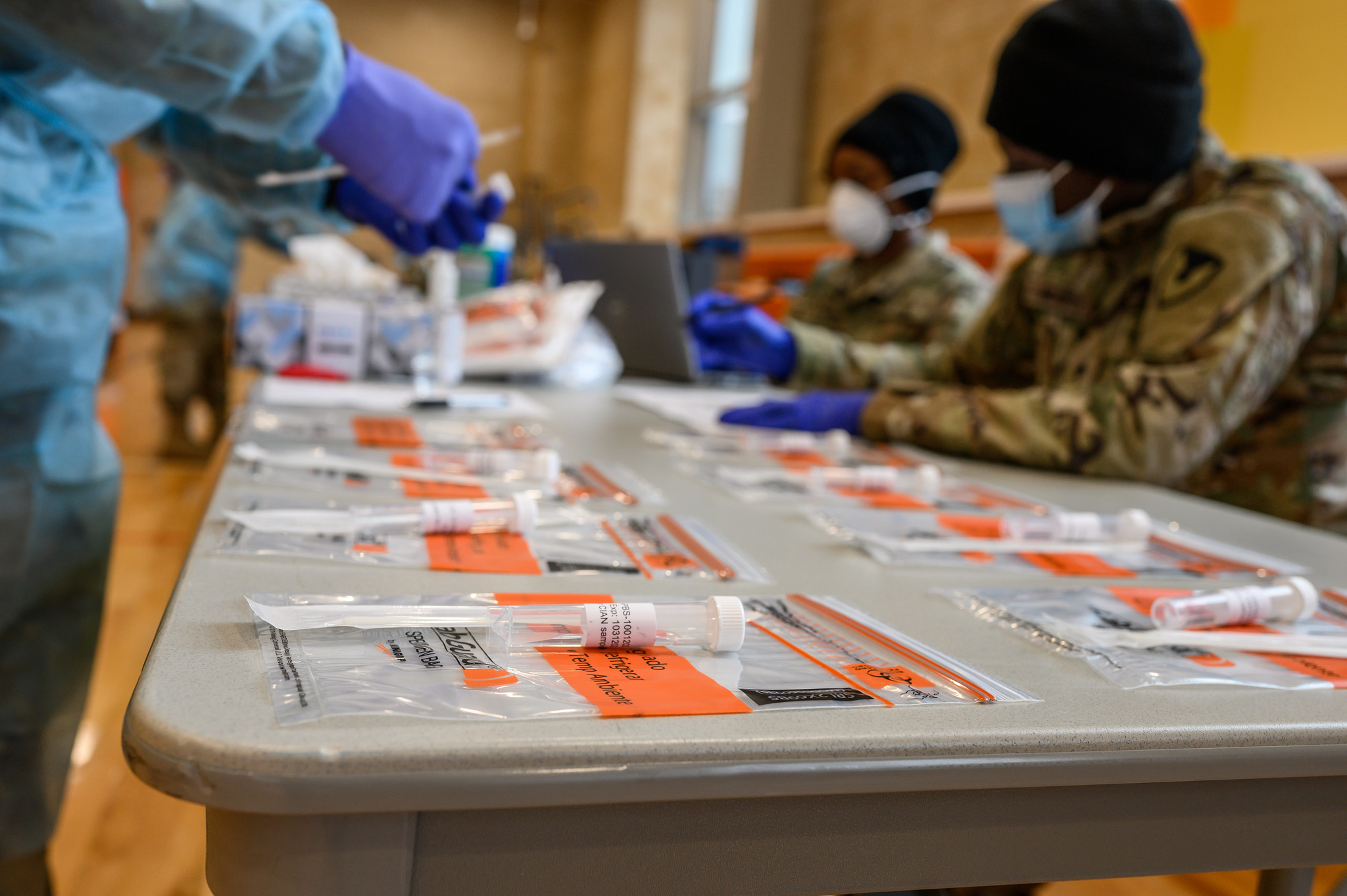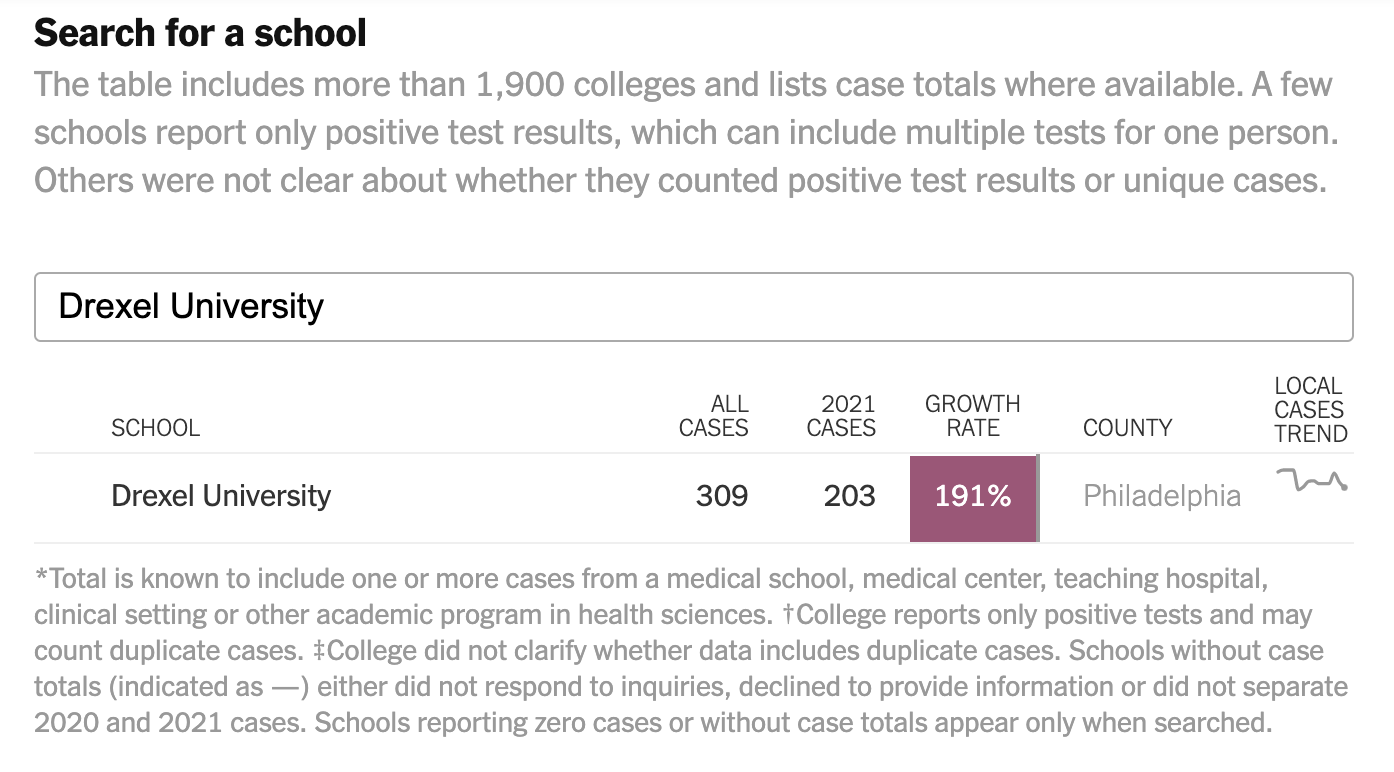
A recent update to the New York Times COVID-19 tracker revealed a statistic about Drexel University which came as a shock to many, but Dr. Marla Gold, Professor and Dean Emerita of Health Management and Policy, says it was misleading and invalid.
The New York Times publishes frequent updates on its COVID-19 case tracker, particular to colleges and universities around the nation. The outlet is currently reporting that Drexel University is experiencing a 191 percent growth rate in Covid-19 cases.
“This [report], to me, was not even comparing apples and oranges,” Gold said. “This, to me, was an attempt to compare fruits and vegetables, and it didn’t work.”
Gold credits a lack of set methodology on data collection at the New York Times as the cause of this misinformation. The report likely used data published by Drexel on its public COVID-19 dashboard, which was not live until October, Gold said.
“Not until October did we begin to publish [data] on a public dashboard in a more organized way,” Gold said. “The vast majority of institutions of higher education [included in the New York Times report] have semesters, while we have quarters. The time span of a semester and a quarter is very different. When we [published] data in October, it was very close to [the start of] students arriving on Drexel’s campus.”
Hand in hand with the difference in start time, Gold urges consideration of a different startup period of mandatory testing at Drexel, different testing methodologies and populations who choose to get tested and how often.
Drexel began its testing procedures with optional testing and baseline testing prior to launching its own testing center, available to all students at all times, which opened in October.
“Gateway testing started in September,” Gold said. “Students did have testing available. The change that happened in October was that [Drexel] set up [its] own full lab, offering testing as soon as possible for all students who want it.”
And, evident through Drexel’s increased testing over the past several months, the university’s infection numbers have remained quite low, slightly lower than many comparable institutions, despite the New York Times report, Gold said.
The World Health Organization wants a positivity rate of below 5 percent. And, to date, Drexel has consistently maintained a positivity rate of under 2 percent, Gold said.
Gold said the University did see an uptick in cases following Halloween, presumably due to student activity. However, around Winter Break and the holidays, the numbers did not increase nearly as much. Additionally, when the City of Philadelphia’s positivity rate increased dramatically following the summer months, Drexel’s did not.
“I’m proud to say that, while the city rose to above 13 percent [positivity rate], our Dragons were always below 2 percent, on the seven days [period].”
Drexel has decided to update figures on its COVID-19 dashboard on a weekly basis, released each Sunday night, Gold said, because it was frequent enough to “give [Drexel] good data.”
Gold also highlighted the number of disclaimers and amount of “fine print” included in the New York Times report, which make comparing institutions included on the list difficult.
“The take-home message is that the New York Times has no set methodology, they produced a figure that is not [acceptable] to measure anything by,” Gold said. “The figure erroneously suggested that we had an outbreak on campus between 2020 and 2021, and that could not be further from the truth.”

In order to prevent a serious outbreak from happening on Drexel’s campus, Gold says the most effective measure is the wearing of face masks.
“We keep saying it, but the number one most important thing is [wearing] face masks,” Gold said.
Gold also explained that a normal ebb-and-flow in COVID-19 infections is normal, and should not be used as an opportunity to point blame. She encourages members of the Drexel community to continue being careful and complacent, especially in the warmer months ahead, and reassures that we are close to “the finish line.”
“This pandemic has evolved quickly over time, going from a deadly infection – not that it is not still deadly – but to vaccine availability in a year. That is hyperspeed. No disease has ever [progressed] like this in science.”
Gold also reassures that no evidence has shown new COVID-19 variants forming on Drexel’s campus.
“To date, there is no evidence of new variants, but we do have another round of testing [happening] this week to check,” she said. “So, we are looking.”
In addition to keeping everyone safe, a goal on the top of Drexel’s list is to help make college life “a thing again” and return to some degree of normalcy on campus.
“The goal is to educate, contain the disease, get the case rate down on campus and allow us to more fully function,” Gold said.
To best achieve this, Gold says Drexel is going above-and-beyond in its efforts to mitigate the spread of Covid-19 on campus. This includes requiring a minimum 10-day quarantine period, although the Centers for Disease Control and Prevention only mandates seven days. Gold says this helps keep from “missing infections.”
Gold said that Drexel does not want its community members to become “numbers.”
“Every day, a team meets and we look at the day [prior]’s infection reports and we talk about the case investigation,” Gold said. “We make sure that we coordinate between Mental Health and Counseling, Student Conduct, Student Health, and we get a report on percentages in quarantine, isolation and beds available.”
“People are most important. I want to [emphasize] that no student [who is in our testing program] has been seriously ill, and we thank God for that.”
Updated statistics on COVID-19 infections are posted weekly to Drexel’s dashboard, which can be viewed on its website here.

